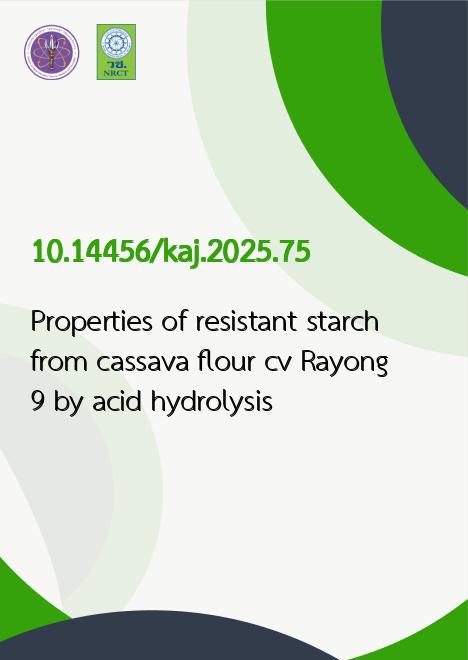
|
Properties of resistant starch from cassava flour cv. Rayong 9 by acid hydrolysis |
|---|---|
| รหัสดีโอไอ | |
| Creator | Chalermwoot Sompark |
| Title | Properties of resistant starch from cassava flour cv. Rayong 9 by acid hydrolysis |
| Contributor | Jarurat Pumprasert, Kritsadaphon Phonwong, Naruthep Wechpibal, Phatthara Loogruk |
| Publisher | Faculty of Agriculture |
| Publication Year | 2568 |
| Journal Title | Khon Kaen Agriculture Journal |
| Journal Vol. | 53 |
| Journal No. | 5 |
| Page no. | 1099-1113 |
| Keyword | Cassava cv. Rayong 9, resistant starch, acid hydrolysis |
| URL Website | https://li01.tci-thaijo.org/index.php/agkasetkaj |
| Website title | Khon Kaen Agriculture Journal |
| ISSN | 3027-6497 (Online) |
| Abstract | Modification of starch to enhance resistant starch (RS) content has attracted growing interest because of its health benefits. Acid hydrolysis is considered a simple, safe, and scalable approach applicable to both smallholder and industrial production. However, its effectiveness in cassava flour remains unclear. This study aimed to investigate the potential of organic acid hydrolysis to produce RS-enriched cassava flour and evaluate its physicochemical properties for application in health-promoting food products. Cassava flours from three varieties recommended by the Department of Agriculture (Rayong 9, Rayong 11, and Rayong 15) were analyzed for yield, nutritional composition, and RS content. Rayong 9 exhibited the highest flour yield (28.60%), amylose content (26.27%), and RS content (3.84%). To further increase RS levels, Rayong 9 cassava flour was treated with citric acid and acetic acid at concentrations of 1.5, 2.0, and 2.5 M for 24 hours, compared with a control (distilled water). Treatments with 1.5–2.0 M acid slightly increased RS content, but the change was not statistically significant. Acid-hydrolyzed samples showed increased glossiness and brightness but reduced viscosity. Scanning electron microscopy revealed rougher starch granule surfaces compared to the control. Overall, the results indicate that organic acid hydrolysis is ineffective for enhancing RS content in cassava flour cv. Rayong 9, suggesting that alternative modification methods such as enzymatic or heat–moisture treatments should be further explored. |